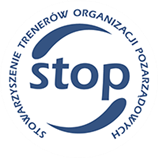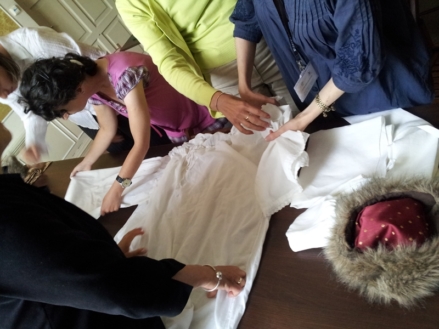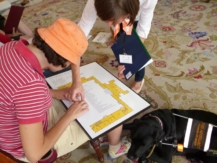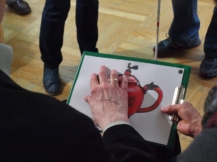Interview with Marta Walewska from the Department of Education in Museum King Jan III’s Palace in Wilanów
Museum’s Offer addressed to visually impaired persons:
- A mock up of the palace blocks designed for touching, located in the lobby museum (next to the locker room) is an introduction to the visit to the museum.
- Events organized by the Museum are adapted to the needs of visually impaired persons, including meetings in the museum, themed walks, nature tours, and workshops. The meetings ware accompanied by live audiodescription, numerous materials are tactile.
- Audiodescription of selected objects is available on the website of the museum.
Olga Kożuchowska: What activities are addressed to visually impaired persons?
Marta Walewska: Museum has fixed offer for visually impaired persons, e. g. themed walks for adults: “Meet the Palace of… audio description” and “Life Sciences trail with audiodescription,” museum lessons and numerous concerts. We are constantly working on extending the offer.
This year (2015), thanks to external funding, we’ve prepared a lot of touching aids. The future plans include touching mock-up of the palace and gardens of Wilanów and more detailed plans for the palace and gardens. We are also in the process of work on audiodescription of the most important and interesting of rooms and exhibits. We do not forget about the children. We are preparing a track with audiodescription for the youngest.
Our offer also includes museum lessons, some of them are adapted to the needs of visually impaired persons (we’re using a variety of tactile aids and audiodescription). We are extending the scope of the lessons.
What are this lessons referring to?
There is a wide range of topics raised during this lessons, starting from historical issues, through topics related to culture, customs, fashion, culinary, to the issues of nature. They are addressed to different age groups: kindergartens, primary schools, lower and upper secondary schools. Classes are interactive, kids and youth enjoy it and they are interested in each lesson issue.
We give effort to prepare the offer for schools available also for groups with special needs. The first lesson I have adapted to the needs of visually impaired persons was “visit to the king,” – meeting with King Jan IIIrd and his family. In preparation there are next lessons. Historical lessons require tactile aids. However, we are looking for different solutions to make them interesting, well prepared and at the same time within our financial capabilities. We prepare tyflographicks, replicas, historical costumes that can be touched, tried on.
It is much easier to prepare walks through the historical gardens, because there we have more freedom, we can touch more things. Recently another new topic – Morysin reservation, where we plan to organize inter alia, tours with audio description.
For how long have you been realizing these activities?
Intensively from approx. two to three years.
What are your impressions after these two years? Does the popularity of your activities increase?
When it comes to a group of visually impaired persons, the interest in this group is definitely growing. The work is very pleasant, because the participants at those meetings are always very interested in these topics. We even have a regular group of people who come to us quite regularly. I hope that we will have more and more on this meetings. Due to the nature of work and places the optimal number of people in the group of all walks with audiodescription is 8-10 people.
How often do you host such meetings?
On average, once a month. In the spring and summer we organize more activities in the garden. In June, there were two walks, one was in Morysin, the second – in the Rose Garden. Now the roses smell so intensely and beautifully that we really wanted to show it.
How do you get through to the target group? Is it easy or difficult?
We cooperate with the Foundation for Culture Without Barriers, Vis Maior Foundation, we have a profile on Facebook and continuously work towards better promotion of our activities. I contact organizations that work every day with blind and visually impaired people. We send information to our individual clients, if they so agree during a visit to the Museum. We also have leaflets in Brail. Participation in conferences and meetings that involve people with sight disabilities, is also a good opportunity to present our offer.
Do you use needs research of visually impaired persons to prepare an offer or you do this without consultation?
At the moment the offer is created rather arbitrarily. But during the walks we often talk about the needs of our visitors about the museum’s offer and one of the results of these talks will be workshops on conservation. Scenarios are ready, I hope that the workshops will commence this year. During the workshop, you’ll want as much as possible energize participants. Let’s see how this is true. We hope that the workshops will be an opportunity to provide the audience with many practical and useful information and skills.
We are also thinking about the survey which will explore our visually impaired guests expectations. This will be the next step. I hope we will mange this still this year.
At the moment the offer is created rather arbitrarily. But during the walks often we talk about the needs of our visitors about the museum offer and one of the results of these talks will be workshop about conservation. Scenarios are ready, I hope that the workshops will commence this year. During the workshop, we want to as much as possible activate participants. Let’s see how this will work. We hope that the workshops will be an opportunity to provide the audience with many practical and useful information and skills.
How do you prepare for this job?
First of all, we organize trainings on the specifics of working with a person with sight disability. The first trainings are addressed to so cold “first contact employees”. We cooperate among others with Vis Maior Foundation, which did for us training I mentioned above, and Culture Without Barriers Foundation, which prepares educators to audiodescription. Such training and contact with people with sight disabilities allow you to get familiar with the topic.
Participation in training is not mandatory. However, only those who will be trained and have a predisposition to continue to work with blind people shall keep such meetings. For this work we are looking for sensitive and empathetic people.
From the surveys, which we ask to fulfill after the classes, we find out that the method of teaching was good or prepared aids were indeed useful, we also ask what is to improve, to change.
Who are participants of walks and meetings? Are there only people from Warsaw or also from the whole Poland?
From the individual offer benefit rather people from Warsaw and the surroundings, but people come to us from all over Poland. They come to us often as organized groups. Then we reserve a time for the group and prepare audiodescription and tactile aids.
What are you satisfied?
The fact that there is interest in what we do, and that this is really needed for this people. Ther is frequency, which for us means that it is worth it to continue our work.
What is your challenge at that moment?
Lack of time is a challenge. People with sight disability are only one of the groups of people with disabilities. We still have a lot of work in adapting the offer to other groups, including e. g. people with autism.
Do you have plans join these groups, so you would not have to prepare for them separable offer?
On our walks with audiodescription can come blind people, partially sighted and sighted. Recently for a walk came also people with mental disability, so we don’t put any restrictions here. However, at the moment we do not offer classes fully inclusive for all, regardless of disability. Our experience shows that the needs of the recipients are closer, the more satisfaction from taking part in the meeting or workshop, that’s why at the moment we are rather in this way shaping our offer.
Is the offer free?
With a fee it is differently. At the moment there is no such decree, which would said that people with disabilities come anywhere free of charge. There are discounts that we use in accordance with regulations. For example, the cost of the participation in the average two-hour walk with adiodescription is now 10 zł. But not all events are paid. Increasingly, we have the ability to create free offer, about which we always inform.
What are your plans?
Terminate projects that have now started. They will give us a base material for visually impaired persons, or mock-ups, guides in Brail, a lot of audiodescription. Later, we will work on projects of workshops in collaboration with the people who every day work intensively with blind. We also want to provide temporary exhibitions which we have at the museum from time to time. I create activities tailored to the needs of new groups with disabilities
What are your wishes at the moment?
Perseverance, strength and frequency.




